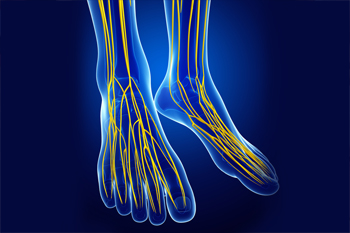159 North 3rd Street
Macclenny, Florida 32063
 Poor circulation may occur when there is an insufficient amount of blood flow to a particular region of the body, commonly affecting the feet. Patients with poor circulation have noticed symptoms including numbness, muscle cramps, and throbbing or tingling pains. Poor circulation may also be an indicator for possible nerve damage. One of the more serious symptoms caused by poor circulation is a loss of feeling in the feet. This can be incredibly dangerous, especially if you have developed a harmful foot condition and can not feel the symptoms that would lead you to seek help and get care. To help improve poor circulation, it’s recommended that you increase your mobility and practice a more active lifestyle. Elevating the feet is another tip to help improve poor circulation, as it makes it easier for your body to pump blood away from the feet and back up to the heart. Making sure you stay hydrated throughout the day, managing your blood sugar levels, and implementing more foods that are rich in iron into your diet, may all help to improve circulation as well. For more advice on how to improve poor circulation, we recommend you speak with a podiatrist for professional care.
Poor circulation may occur when there is an insufficient amount of blood flow to a particular region of the body, commonly affecting the feet. Patients with poor circulation have noticed symptoms including numbness, muscle cramps, and throbbing or tingling pains. Poor circulation may also be an indicator for possible nerve damage. One of the more serious symptoms caused by poor circulation is a loss of feeling in the feet. This can be incredibly dangerous, especially if you have developed a harmful foot condition and can not feel the symptoms that would lead you to seek help and get care. To help improve poor circulation, it’s recommended that you increase your mobility and practice a more active lifestyle. Elevating the feet is another tip to help improve poor circulation, as it makes it easier for your body to pump blood away from the feet and back up to the heart. Making sure you stay hydrated throughout the day, managing your blood sugar levels, and implementing more foods that are rich in iron into your diet, may all help to improve circulation as well. For more advice on how to improve poor circulation, we recommend you speak with a podiatrist for professional care.
While poor circulation itself isn’t a condition; it is a symptom of another underlying health condition you may have. If you have any concerns with poor circulation in your feet contact Dr. John L. Coleman of Florida. Our doctor will treat your foot and ankle needs.
Poor Circulation in the Feet
Peripheral artery disease (PAD) can potentially lead to poor circulation in the lower extremities. PAD is a condition that causes the blood vessels and arteries to narrow. In a linked condition called atherosclerosis, the arteries stiffen up due to a buildup of plaque in the arteries and blood vessels. These two conditions can cause a decrease in the amount of blood that flows to your extremities, therefore resulting in pain.
Symptoms
Some of the most common symptoms of poor circulation are:
Treatment for poor circulation often depends on the underlying condition that causes it. Methods for treatment may include insulin for diabetes, special exercise programs, surgery for varicose veins, or compression socks for swollen legs.
As always, see a podiatrist as he or she will assist in finding a regimen that suits you. A podiatrist can also prescribe you any needed medication.
If you have any questions, please feel free to contact our office located in Macclenny, FL . We offer the newest diagnostic and treatment technologies for all your foot care needs.